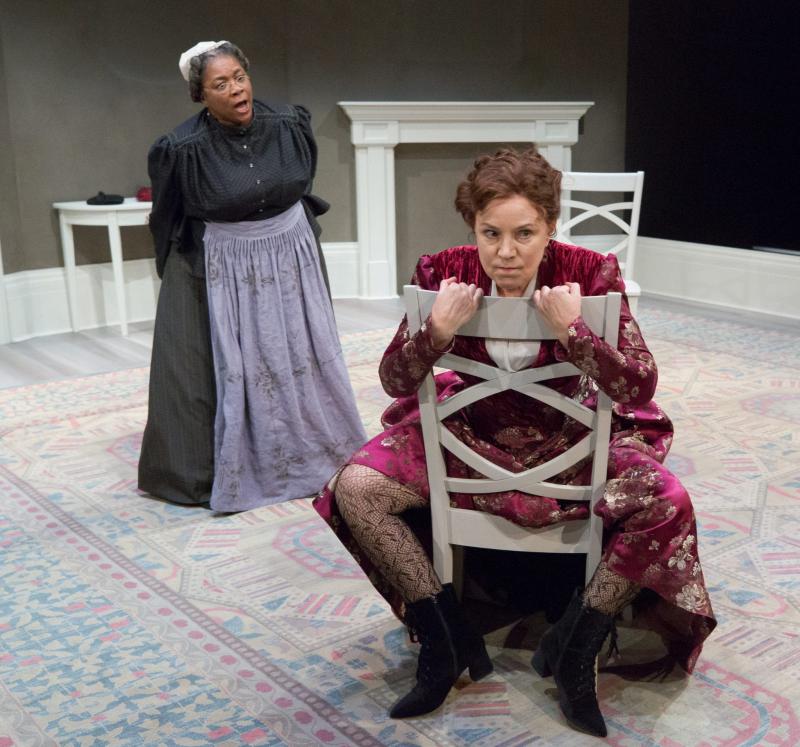Review: A DOLL'S HOUSE PART 2 at Arden Theatre Co.

Bold choices. Beautiful staging. This is Arden Theatre Company's production of A Doll's House Part 2.
If you don't know the show, it's a kind of continuation of life for Henrik Ibsen's A Doll's House characters. Nora, a once-housewife who walked out on her family to build an independent life comes back after realizing her husband never filed for divorce. Nora's loud, brazen character in Part 2 is unrecognizable from her timid portrayal in Ibsen's original.
Nora's first appearance in Ibsen's 1879 play was met with criticism from audiences and offended some so much that the play was banned in Britain shortly after premiering. The Arden's production and director, Tracy Brigden, take this fact and run with it.
) is at first glance one-dimensional: she's a feminist writer with controversial ideas and a burning need to defend them to anyone who disagrees. Her insistence that she Grace GonglewskiNora (is right comes off as aggressive and at times, insensitive.
Nora tells her daughter Emmy (Grace Tarves) that she believes in love but not the contract of marriage. However, this belief in love rarely comes through -- Nora is too insistent on being independent and having her own ideas to show any genuine tenderness toward the children she left behind or the husband she says she once loved. This came off as utterly disingenuous acting until I realized that distancing herself from real, deep feelings is exactly what Nora would do.
Steven After meeting her former husband, Torvald (Rishard), Nora shows no glimpse into possible lingering feelings. Rishard plays Torvald with such conviction that Nora's lack of feeling is obvious. His clear and intense depression after her original exit made me sympathetic toward his cause, and a little annoyed at Nora's lack of tenderness.
This, to me, is brilliant, because audiences get to have the same sort of reaction to Nora that audiences in 1879 did. Ibsen's A Doll's House was not always regarded as the feminist work it is today.
Despite the show's serious themes of family, independence, and love, the four person cast makes a point to incorporate levity through the one act production.
), the house help, has her own problems after Nora Joilet HarrisAnne Marie (leaves, but glows as the comedic center of the play. Harris glows as an older woman who has been through too much to take criticism from anyone, especially Nora. When she is on stage, the audience both understands the hardships that have come with becoming the woman of the household and laughs out loud at her "are you kidding me?" attitude.
As unlikable as Nora is in this production, Gonglewski hits every comedic beat, and Rishard, after flexing his dramatic skills at the start of the play, shows he has the comedy down pat in the climactic final scene.
The Arden also shined when it came to keeping me engaged despite a lack of glitz - no glamourous costumes or impressive set pieces - that comes with producing this minimalist play.
The Arden always finds a way to be innovative with staging, and set designer Jorge Cousineau and lighting designer Brian Sidney Bembridge did not disappoint. Along with the typical empty home with two chairs, the production team brings the audience inside the dollhouse by hanging molding above the audience. Projections of lines from Ibsen's A Doll's House scrolled across the molding before the lights dimmed, bringing me into Nora's world before she ever steps through the door.
The roughly 150-seat Arcadia Stage theater had a square stage at the center that was surrounding three-quarters by the audience. Director Brigden had characters enter and leave through the same aisles and doors the audience had, further drawing them into the story. After the final bows, the audience dropped their extra playbills on a tea table that was used briefly in the show - a reminder that you can't leave a doll's house until you deliberately decide to.
left me thinking about the themes of family, love, and marriage you can extract from reading the script, and A Doll's House Part 2In the end, the Arden's an unique look at history you wouldn't get otherwise.
The production runs through December 9th and tickets can be purchased at ardentheatre.org
Photo Credit: Mark Garvin
Reader Reviews

Videos

